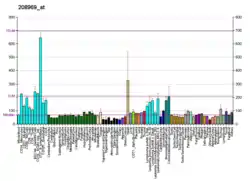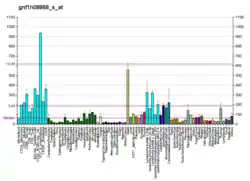NDUFA9
NADH dehydrogenase [ubiquinone] 1 alpha subcomplex subunit 9 is an enzyme that in humans is encoded by the NDUFA9 gene.[5][6][7] The NDUFA9 protein is a subunit of NADH:ubiquinone oxidoreductase (Complex I of the electron transport chain), which is located in the mitochondrial inner membrane and is the largest of the five complexes of the electron transport chain.[8][9] Mutations in NADH dehydrogenase (ubiquinone), also known as Complex I, frequently lead to complex neurodegenerative diseases such as Leigh's syndrome. In the case of NDUFA9, a mutation to the MT-ND3 gene might interrupt their interaction and formation of subcomplexes, compromising Complex I function and leading to disease.[10]
Structure
The NDUFA9 gene is located on the p arm of chromosome 12 in position 13.3 and spans 45,222 base pairs.[5] The gene produces a 42.5 kDa protein composed of 377 amino acids.[11][12] NDUFA9 is a subunit of the enzyme NADH dehydrogenase (ubiquinone), the largest of the respiratory complexes. The structure is L-shaped with a long, hydrophobic transmembrane domain and a hydrophilic domain for the peripheral arm that includes all the known redox centers and the NADH binding site.[8] It has been noted that the N-terminal hydrophobic domain has the potential to be folded into an alpha helix spanning the inner mitochondrial membrane with a C-terminal hydrophilic domain interacting with globular subunits of Complex I. The highly conserved two-domain structure suggests that this feature is critical for the protein function and that the hydrophobic domain acts as an anchor for the NADH dehydrogenase (ubiquinone) complex at the inner mitochondrial membrane. NDUFA9 is one of about 31 hydrophobic subunits that form the transmembrane region of Complex I, but it is an accessory subunit that is believed not to be involved in catalysis.[13] The predicted secondary structure is primarily alpha helix, but the carboxy-terminal half of the protein has high potential to adopt a coiled-coil form. The amino-terminal part contains a putative beta sheet rich in hydrophobic amino acids that may serve as mitochondrial import signal.[5][9][14]
Function
The human NDUFA9 gene codes for a subunit of Complex I of the respiratory chain, which transfers electrons from NADH to ubiquinone.[5] NADH binds to Complex I and transfers two electrons to the isoalloxazine ring of the flavin mononucleotide (FMN) prosthetic arm to form FMNH2. The electrons are transferred through a series of iron-sulfur (Fe-S) clusters in the prosthetic arm and finally to coenzyme Q10 (CoQ), which is reduced to ubiquinol (CoQH2). The flow of electrons changes the redox state of the protein, resulting in a conformational change and pK shift of the ionizable side chain, which pumps four hydrogen ions out of the mitochondrial matrix.[8]
Clinical significance
Decreased expression of NDUFA9 is associated with Leigh's syndrome, a severe neurological disorder that typically arises in the first year of life, is characterized by progressive loss of mental and movement abilities, and typically results in death within a couple of years, usually due to respiratory failure. A mutation in the MT-ND3 gene (tyrosine to cytosine at the 10191 position) results in a substitution of serine for proline, which may introduce instability of Complex I due to the inability form subcomplexes between MT-ND3 and NDUFA9. However, this genetic identification may not be suitable for prenatal testing because of the mutation's age and tissue dependence.[10]
Interactions
NDUFA9 has been shown to have 135 binary protein-protein interactions including 112 co-complex interactions. NDUFA9 appears to interact with BLOC1S1, NDUFS1, NOA1, CYSRT1, KRTAP6-2, CIAO1, MT-ND3, TSC22D1, DNAJA3, SIRT3, MAGED1, and SSR1.[15]
References
- GRCh38: Ensembl release 89: ENSG00000139180 - Ensembl, May 2017
- GRCm38: Ensembl release 89: ENSMUSG00000000399 - Ensembl, May 2017
- "Human PubMed Reference:". National Center for Biotechnology Information, U.S. National Library of Medicine.
- "Mouse PubMed Reference:". National Center for Biotechnology Information, U.S. National Library of Medicine.
- "Entrez Gene: NDUFA9 NADH dehydrogenase (ubiquinone) 1 alpha subcomplex, 9".
- Baens M, Chaffanet M, Cassiman JJ, van den Berghe H, Marynen P (April 1993). "Construction and evaluation of a hncDNA library of human 12p transcribed sequences derived from a somatic cell hybrid". Genomics. 16 (1): 214–8. doi:10.1006/geno.1993.1161. PMID 8486360.
- Persson B, Kallberg Y, Bray JE, Bruford E, Dellaporta SL, Favia AD, Duarte RG, Jörnvall H, Kavanagh KL, Kedishvili N, Kisiela M, Maser E, Mindnich R, Orchard S, Penning TM, Thornton JM, Adamski J, Oppermann U (March 2009). "The SDR (short-chain dehydrogenase/reductase and related enzymes) nomenclature initiative". Chemico-Biological Interactions. 178 (1–3): 94–8. doi:10.1016/j.cbi.2008.10.040. PMC 2896744. PMID 19027726.
- Voet D, Voet JG, Pratt CW (2013). "Chapter 18". Fundamentals of biochemistry: life at the molecular level (4th ed.). Hoboken, NJ: Wiley. pp. 581–620. ISBN 978-0-470-54784-7.
- Emahazion T, Beskow A, Gyllensten U, Brookes AJ (Nov 1998). "Intron based radiation hybrid mapping of 15 complex I genes of the human electron transport chain". Cytogenetics and Cell Genetics. 82 (1–2): 115–9. doi:10.1159/000015082. PMID 9763677. S2CID 46818955.
- Leshinsky-Silver E, Lev D, Tzofi-Berman Z, Cohen S, Saada A, Yanoov-Sharav M, Gilad E, Lerman-Sagie T (August 2005). "Fulminant neurological deterioration in a neonate with Leigh syndrome due to a maternally transmitted missense mutation in the mitochondrial ND3 gene". Biochemical and Biophysical Research Communications. 334 (2): 582–7. doi:10.1016/j.bbrc.2005.06.134. PMID 16023078.
- Zong NC, Li H, Li H, Lam MP, Jimenez RC, Kim CS, Deng N, Kim AK, Choi JH, Zelaya I, Liem D, Meyer D, Odeberg J, Fang C, Lu HJ, Xu T, Weiss J, Duan H, Uhlen M, Yates JR, Apweiler R, Ge J, Hermjakob H, Ping P (October 2013). "Integration of cardiac proteome biology and medicine by a specialized knowledgebase". Circulation Research. 113 (9): 1043–53. doi:10.1161/CIRCRESAHA.113.301151. PMC 4076475. PMID 23965338.
- "NDUFA9 - NADH dehydrogenase [ubiquinone] 1 alpha subcomplex subunit 9". Cardiac Organellar Protein Atlas Knowledgebase (COPaKB).
- "NDUFA9 - NADH dehydrogenase [ubiquinone] 1 alpha subcomplex subunit 9, mitochondrial". UniProt.org. The UniProt Consortium.
- Ton C, Hwang DM, Dempsey AA, Liew CC (December 1997). "Identification and primary structure of five human NADH-ubiquinone oxidoreductase subunits". Biochemical and Biophysical Research Communications. 241 (2): 589–94. doi:10.1006/bbrc.1997.7707. PMID 9425316.
- "135 binary interactions found for search term NDUFA9". IntAct Molecular Interaction Database. EMBL-EBI. Retrieved 2018-08-25.
Further reading
- van den Bosch BJ, Gerards M, Sluiter W, Stegmann AP, Jongen EL, Hellebrekers DM, Oegema R, Lambrichs EH, Prokisch H, Danhauser K, Schoonderwoerd K, de Coo IF, Smeets HJ (January 2012). "Defective NDUFA9 as a novel cause of neonatally fatal complex I disease". Journal of Medical Genetics. 49 (1): 10–5. doi:10.1136/jmedgenet-2011-100466. PMID 22114105.
- Ewing RM, Chu P, Elisma F, Li H, Taylor P, Climie S, McBroom-Cerajewski L, Robinson MD, O'Connor L, Li M, Taylor R, Dharsee M, Ho Y, Heilbut A, Moore L, Zhang S, Ornatsky O, Bukhman YV, Ethier M, Sheng Y, Vasilescu J, Abu-Farha M, Lambert JP, Duewel HS, Stewart II, Kuehl B, Hogue K, Colwill K, Gladwish K, Muskat B, Kinach R, Adams SL, Moran MF, Morin GB, Topaloglou T, Figeys D (2007). "Large-scale mapping of human protein-protein interactions by mass spectrometry". Molecular Systems Biology. 3 (1): 89. doi:10.1038/msb4100134. PMC 1847948. PMID 17353931.
- Vogel RO, Dieteren CE, van den Heuvel LP, Willems PH, Smeitink JA, Koopman WJ, Nijtmans LG (March 2007). "Identification of mitochondrial complex I assembly intermediates by tracing tagged NDUFS3 demonstrates the entry point of mitochondrial subunits". The Journal of Biological Chemistry. 282 (10): 7582–90. doi:10.1074/jbc.M609410200. PMID 17209039.
- Ma J, Dempsey AA, Stamatiou D, Marshall KW, Liew CC (March 2007). "Identifying leukocyte gene expression patterns associated with plasma lipid levels in human subjects". Atherosclerosis. 191 (1): 63–72. doi:10.1016/j.atherosclerosis.2006.05.032. PMID 16806233.
- Triepels RH, Hanson BJ, van den Heuvel LP, Sundell L, Marusich MF, Smeitink JA, Capaldi RA (March 2001). "Human complex I defects can be resolved by monoclonal antibody analysis into distinct subunit assembly patterns". The Journal of Biological Chemistry. 276 (12): 8892–7. doi:10.1074/jbc.M009903200. PMID 11112787.
- Loeffen JL, Triepels RH, van den Heuvel LP, Schuelke M, Buskens CA, Smeets RJ, Trijbels JM, Smeitink JA (December 1998). "cDNA of eight nuclear encoded subunits of NADH:ubiquinone oxidoreductase: human complex I cDNA characterization completed". Biochemical and Biophysical Research Communications. 253 (2): 415–22. doi:10.1006/bbrc.1998.9786. PMID 9878551.
- Cross SH, Charlton JA, Nan X, Bird AP (March 1994). "Purification of CpG islands using a methylated DNA binding column". Nature Genetics. 6 (3): 236–44. doi:10.1038/ng0394-236. PMID 8012384. S2CID 12847618.
- Fearnley IM, Finel M, Skehel JM, Walker JE (September 1991). "NADH:ubiquinone oxidoreductase from bovine heart mitochondria. cDNA sequences of the import precursors of the nuclear-encoded 39 kDa and 42 kDa subunits". The Biochemical Journal. 278 ( Pt 3) (3): 821–9. doi:10.1042/bj2780821. PMC 1151420. PMID 1832859.
This article incorporates text from the United States National Library of Medicine, which is in the public domain.





